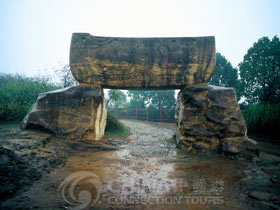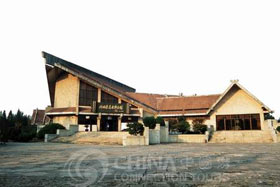 Hemudu Culture Relics, named after a nearby village of Yuyao City, is located 25 kilometers west of Ningbo. Surrounded by Siming Mountain on the south, Yuyao Plain on the north and Menqian Mountain on the east, it was formerly named Huangmudu that dates back to the Neolithic Age. Hemudu Cultural Relics was uncovered in 1973 and a total of 2,800 m2 has been unearthed through two phases of excavation efforts. With a history of more than 6900 years, Hemudu Cultural Relics has unveiled a well of unique and time-honored culture, and was hence called the "Hemudu Culture" in the academic circles. Hemudu Cultural Relics cover an area of 40,000 m2 and is made up of four cultural strata that are inherently correlated and lay one upon another. It spans a history of some 2000 years between the formation of the first stratum 7,000 years ago and that of the fourth stratum 5000 years ago. About 7,000 cultural relics have been unearthed after two explorations.
Hemudu Culture Relics, named after a nearby village of Yuyao City, is located 25 kilometers west of Ningbo. Surrounded by Siming Mountain on the south, Yuyao Plain on the north and Menqian Mountain on the east, it was formerly named Huangmudu that dates back to the Neolithic Age. Hemudu Cultural Relics was uncovered in 1973 and a total of 2,800 m2 has been unearthed through two phases of excavation efforts. With a history of more than 6900 years, Hemudu Cultural Relics has unveiled a well of unique and time-honored culture, and was hence called the "Hemudu Culture" in the academic circles. Hemudu Cultural Relics cover an area of 40,000 m2 and is made up of four cultural strata that are inherently correlated and lay one upon another. It spans a history of some 2000 years between the formation of the first stratum 7,000 years ago and that of the fourth stratum 5000 years ago. About 7,000 cultural relics have been unearthed after two explorations.
In the first excavation from November 4th 1973 to January 10th 1974, more than 1600 pieces of production tools, utensils for daily use and decorative materials made of stone, animal bones, wood and pottery were exposed to the world.
The remnants of at least 61 animals have also been unearthed in Hemudu, most of which are wild animals in addition to the tamed ones such as pigs, dogs and water buffaloes. The major part of animals comprise: the Asian elephants and rhinoceros, which love mild temperature and moisture, ferocious tigers, wolves and bears, lovely and tame sambars and spotted deer, nimble macaques and red-faced monkeys, and all kinds of fish, river clams, Yangtze crocodiles and birds. Moreover, the historical remains of 24 species of plants in Hemudu have been unearthed, for instance, piles of acorns, water caltrop and sour date. All these show the natural scene of ancient time: a humid and hot area spotted by large lakes; wild animals ran in the primitive forest teeming with fruits and lotus seeds were floating over the lake. The Ning-Shao plain of 6,000-7,000 years ago looked much like the Yunnan Province's Xishuangbanna of today.
 The fourth stratum of Hemudu Relics is most important. A large pile of rice has been discovered, averaging over 20 cm in height, with the highest one being 80 cm. The rice grains, leaves and chaffs are well preserved. We could see very clearly the fibrous roots, veins and ears when they were unearthed (See the picture). According to the studies of agronomists, the Hemudu people are believed to have planted the rice. Apart from the rice, Hemudu Cultural Relics also contains a large quantity of ware made of bone, wood, earth and stone. The simple stone ware consists of the axe and chisel only. The earthen ware includes jars, kettles and trays. The predominant part of the ware is the bone ware, most of which were made in a refined way and used widely. The bone-hoe was employed for farming and the bone-whistle for imitating the sound of animals in hunting or as a music instrument. There was also plenty of bone arrow-heads for use in hunting. Moreover, the Hemudu people came to possess and use various utensils in life & production, such as daggers, needles, chisels and spoons, and they also took pride in the hundreds of wooden ware like knives, spears, sticks, shovels, oars, bowls and hammers. The oar they used at that time resembles the modern one, indicating the inhabitants had already conquered the rivers. Also, the discovery of various earthen spinning wheels, bone needles and shuttles reflect that the ancient Hemudu people had learned to weave cloth in a primitive way.
The fourth stratum of Hemudu Relics is most important. A large pile of rice has been discovered, averaging over 20 cm in height, with the highest one being 80 cm. The rice grains, leaves and chaffs are well preserved. We could see very clearly the fibrous roots, veins and ears when they were unearthed (See the picture). According to the studies of agronomists, the Hemudu people are believed to have planted the rice. Apart from the rice, Hemudu Cultural Relics also contains a large quantity of ware made of bone, wood, earth and stone. The simple stone ware consists of the axe and chisel only. The earthen ware includes jars, kettles and trays. The predominant part of the ware is the bone ware, most of which were made in a refined way and used widely. The bone-hoe was employed for farming and the bone-whistle for imitating the sound of animals in hunting or as a music instrument. There was also plenty of bone arrow-heads for use in hunting. Moreover, the Hemudu people came to possess and use various utensils in life & production, such as daggers, needles, chisels and spoons, and they also took pride in the hundreds of wooden ware like knives, spears, sticks, shovels, oars, bowls and hammers. The oar they used at that time resembles the modern one, indicating the inhabitants had already conquered the rivers. Also, the discovery of various earthen spinning wheels, bone needles and shuttles reflect that the ancient Hemudu people had learned to weave cloth in a primitive way.
 The Hemudu people lived a rich intellectual life as seen from the unearthed arts and crafts like color paintings, carvings and knitted articles. The Hemudu people made the earthen ware in a realistic and exaggerated way. For instance, a little dog curled there to guard the gate and fish held its head high or jumped forward. Symmetrical rice ears were carved on the external side of the earthen basin, which showed the wish of Hemudu habitants for harvest. The earliest lacquer ware found in China is the soft-colored water bucket and wooden bowl of Hemudu. The bone dagger has two symmetrical birds engraved on it and the whole picture is vivid and impressive. A total of 20 ivory carvings unearthed vary from one to another, indicating their plain way of thinking and rich artistic imagination.
The Hemudu people lived a rich intellectual life as seen from the unearthed arts and crafts like color paintings, carvings and knitted articles. The Hemudu people made the earthen ware in a realistic and exaggerated way. For instance, a little dog curled there to guard the gate and fish held its head high or jumped forward. Symmetrical rice ears were carved on the external side of the earthen basin, which showed the wish of Hemudu habitants for harvest. The earliest lacquer ware found in China is the soft-colored water bucket and wooden bowl of Hemudu. The bone dagger has two symmetrical birds engraved on it and the whole picture is vivid and impressive. A total of 20 ivory carvings unearthed vary from one to another, indicating their plain way of thinking and rich artistic imagination.

